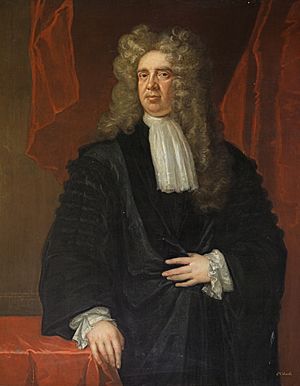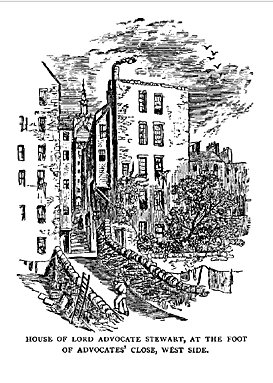James Stewart (advocate, born 1635) facts for kids
Quick facts for kids
James Stewart
|
|
|---|---|

Portrait of Sir James by John Baptist Medina
|
|
| Lord Advocate of Scotland | |
| In office 1711–1713 |
|
| Preceded by | David Dalrymple, 1st Baronet |
| Succeeded by | Thomas Kennedy of Dunure |
| In office 1692–1707 |
|
| Preceded by | John Dalrymple, Earl of Stair |
| Succeeded by | David Dalrymple, 1st Baronet |
| Personal details | |
| Born | 1635 |
| Died | 1713 |
| Nationality | Scottish |
| Spouse | Agnes Traill |
| Children | Sir James Stewart, 1st Baronet Ann Stewart |
| Parents | Sir James Steuart Anne Hope |
| Relatives | Sir Robert Steuart, 1st Baronet (brother) William Mure (son-in-law) Sir James Steuart-Denham (grandson) William Mure (grandson) |
Sir James Stewart (sometimes spelled Steuart) of Goodtrees (1635–1713) was an important Scottish lawyer. He was known for being against the Stuart kings. He also became the Lord Advocate of Scotland from 1692 to 1713, where he made many changes to the law. People who supported the Stuart kings, called Jacobites, gave him the nickname Jamie Wylie.
Contents
Early Life and Family
James Stewart was born in 1635. He was the fourth son of Sir James Steuart of Coltness. His father was a banker in Edinburgh and also served as the Lord Provost of Edinburgh. This role was like being the mayor of the city. James's mother was Anne Hope. She was the niece of Sir Thomas Hope.
James also had two brothers. They were Sir Robert Steuart, 1st Baronet of Allanbank and Sir Thomas Stewart of Coltness, 1st Baronet.
Sir James Stewart's Career
James Stewart became a lawyer on November 20, 1661. Early in his career, he defended his father in a legal case. This case caused him to lose most of his clients and his law practice.
Time in Exile
Stewart had to leave Scotland because he wrote a pamphlet. A pamphlet is a small booklet that shares opinions, often about politics. He went to a city in France called Rouen. There, he worked as a merchant and used a different name, Graham.
Later, he came back to Scotland. But he was suspected of writing another political pamphlet. This one was called An Account of Scotlands Grievances by reason of the Duke of Lauderdale's Ministry (1675). Because of this, the government tried to arrest him. He managed to escape again and hid in England, using the name Lawson.
In 1678, Stewart opened a small office in London. He secretly gave legal advice to people. His clerk would meet clients and pass their questions to Stewart, who stayed hidden. He returned to Scotland in 1679. In 1681, he got into trouble once more. A paper he wrote, which criticized the government, was found among someone else's documents. He had to flee to The Hague in the Netherlands.
In 1685, he was involved in a meeting in Amsterdam. At this meeting, plans were made for an expedition led by Archibald Campbell, 9th Earl of Argyll against the king. Stewart helped write Argyll's declaration. Because of this, he was accused of working against the government. He was found guilty while he was still away from Scotland.
Later Life and Legal Reforms
In 1687, James II of Great Britain pardoned Stewart. This meant he was forgiven for his past actions. Stewart then returned to London. Some people believe he might have been working as a secret agent for both sides. He became favored by the king because he was thought to have influence with a group called the Presbyterians. He was then asked to handle legal cases for the Crown.
After the Glorious Revolution in 1688, Stewart was appointed Lord Advocate in 1692. The Lord Advocate is the chief legal officer in Scotland. During his time in this role, he brought in many new legal changes in Scotland. He was also chosen to be the Dean of the Faculty of Advocates until 1695. This is a leader among lawyers.
In 1696, Stewart was the prosecutor in a famous case. He argued for a severe punishment for a man named Thomas Aikenhead. Stewart believed that a strong example was needed to stop others from expressing similar views. He left his position as Lord Advocate in 1709. Sir James Stewart passed away in 1713. He was buried in Greyfriars Kirkyard.
A famous narrow street in Edinburgh, Advocates Close, is named after him.
Sir James Stewart's Writings
Sir James Stewart wrote several important works. One anonymous book, Naphthali, or, The Wrestlings of the Church of Scotland (1667), is now believed to be written by Stewart and another minister, James Stirling. Stewart wrote the legal parts of this book. It defended a protest called the Pentland Rising of 1666. This protest happened because Presbyterians faced harsh treatment.
In 1669, Stewart published another political pamphlet. It was called Jus Populi Vindicatum, or the People's Right to defend themselves, and their Covenanted Reign vindicated. This book was a response to another work that had criticized Naphthali.
Family Life
Sir James Stewart was married to Agnes Traill (1646-1690). She was the daughter of Reverend Robert Traill. Agnes had been married before to James Maxwell. Sir James and Agnes had several children, but only one son. Their children included:
- Sir James Stewart, 1st Baronet (1681–1727): He became a solicitor-general. He married Anne Dalrymple. Her father was the Lord North Berwick, who was a very important judge.
- Anne Stewart: She married William Mure of Caldwell.
Descendants
Sir James Stewart's grandson was Sir James Steuart-Denham (1713–1780). He was known as the elder Sir James Steuart-Denham. Another grandson was William Mure (1718–1776). He became a Member of Parliament for Renfrewshire.
In Fiction
Sir James Stewart appears as a character in the novel Doubting Thomas (2017) by Heather Richardson.
|


